High-altitude landscape shots captivate you by transforming familiar scenes into abstract wonders. From above, you'll witness vast expanses and hidden patterns that ground-level views can't reveal. Dramatic light and shadows create mesmerizing contrasts, while unique textures and colors emerge in surprising ways. Atmospheric layers add depth and mystery, especially during golden hours. You'll see nature's grandeur unfold through seasonal changes and geological formations. Rivers become serpentine ribbons, and farmlands turn into geometric patchworks. Capturing these breathtaking vistas presents exciting compositional challenges, pushing you to master new techniques and perspectives. The higher you go, the more awe-inspiring the world becomes.
The Allure of Aerial Perspectives

Sky-high vantage points offer photographers a unique way to capture the world below. When you're shooting from high altitudes, you'll find that familiar landscapes transform into abstract patterns and textures. Mountains become ripples, rivers turn into ribbons, and cities morph into intricate mosaics of light and shadow.
The allure of aerial perspectives lies in their ability to reveal hidden beauty and unexpected compositions. You'll discover geometric shapes in agricultural fields, mesmerizing color gradients in natural formations, and the interplay of light across vast expanses. These shots allow you to showcase the grandeur of nature and human-made structures in ways that ground-level photography simply can't match.
From a practical standpoint, high-altitude photography lets you capture expansive scenes that would be impossible to frame from the ground. You'll be able to include multiple elements in a single frame, creating visually rich and complex images.
The elevated viewpoint also eliminates distracting foreground elements, focusing attention on the broader landscape. This unique perspective challenges viewers' perceptions, inviting them to see the world with fresh eyes and appreciate its beauty from a new angle.
Capturing Vast Expanses
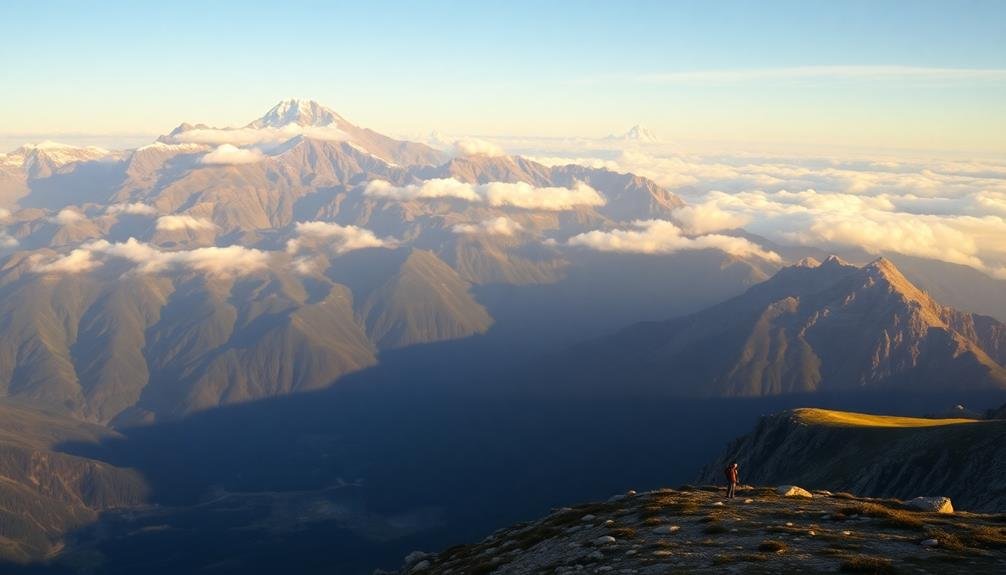
From high altitudes, you'll unfasten breathtaking panoramic views that stretch as far as the eye can see.
You'll capture an amplified sense of scale, showcasing the grandeur of landscapes in ways impossible from ground level.
Your lens will reveal atmospheric layers, creating depth and drama in your shots as light interacts with different elevations.
Panoramic Views Unleashed
At the pinnacle of your high-altitude adventure, panoramic views unfold before you, offering a breathtaking canvas for landscape photography.
These expansive vistas allow you to capture the Earth's curvature, distant horizons, and sweeping terrains in a single frame. You'll find that wide-angle lenses become your best allies, enabling you to encompass more of the scene without sacrificing detail.
To release the full potential of panoramic views, you'll want to experiment with different techniques.
Try creating multi-image panoramas by stitching together a series of overlapping shots. This method allows you to capture an even broader perspective while maintaining high resolution. Don't forget to level your camera and use a sturdy tripod to guarantee seamless alignment.
Consider the time of day when shooting panoramas.
Golden hour and blue hour offer dramatic lighting that can enhance the depth and texture of your landscapes. You'll also want to pay attention to atmospheric conditions. Clear days provide crisp, far-reaching views, while a layer of clouds can add drama and scale to your compositions.
Sense of Scale Amplified
High-altitude landscapes offer a unique opportunity to capture the true vastness of our world. From elevated vantage points, you'll witness expanses that stretch far beyond what's visible at ground level. Mountain ranges, sprawling valleys, and distant horizons unfold before your lens, revealing the Earth's grandeur in a single frame.
To amplify the sense of scale in your high-altitude shots, include recognizable elements in the foreground. A lone tree, a winding road, or a small building can serve as a reference point, emphasizing the immensity of the surrounding landscape.
Use wide-angle lenses to encompass more of the scene, but be mindful of distortion at the edges.
Play with perspective by incorporating layers into your composition. Capture rolling hills, overlapping mountain peaks, or cloud formations at different distances to create depth and enhance the perception of scale.
The interplay of light and shadow across vast areas can further accentuate the landscape's dimensions.
Don't forget to experiment with different times of day. Early morning or late afternoon light can cast long shadows, adding drama and emphasizing the terrain's contours, making the scale even more apparent in your high-altitude landscape shots.
Atmospheric Layers Revealed
One of the most enchanting aspects of high-altitude photography is the ability to reveal Earth's atmospheric layers. When you're shooting from great heights, you'll capture the distinct bands of atmosphere that are usually invisible from the ground. These layers create a stunning visual effect, with each stratum displaying unique colors and textures.
You'll often see the troposphere, where most weather phenomena occur, as a thin, hazy band near the Earth's surface. Above it, you might glimpse the stratosphere, which appears as a clearer, more transparent layer. On rare occasions, you can even capture the mesosphere, visible as a faint blue hue at the edge of space.
To best showcase these atmospheric layers, you'll want to shoot during golden hour or blue hour when the sun's low angle highlights the different strata. Use a wide-angle lens to encompass the vast expanse of sky and landscape.
Experiment with long exposures to enhance the ethereal quality of the layers. Remember to adjust your white balance to accurately represent the subtle color variations between atmospheric bands.
Dramatic Light and Shadows

When shooting high-altitude landscapes, you'll find that dramatic light and shadows can transform your images.
Look for long, sweeping sun rays that slice through the atmosphere, creating dynamic patterns and highlighting specific areas.
You can also capture stunning atmospheric color gradients as the light shifts, and pay attention to the interplay of cloud-cast mountain shadows, which add depth and mystery to your compositions.
Long, Sweeping Sun Rays
Sunbeams stretching across vast landscapes create some of the most dramatic and enchanting high-altitude shots. These long, sweeping sun rays add depth, dimension, and a sense of scale to your photographs. They're often most visible during the golden hours, just after sunrise or before sunset, when the sun's angle is low on the horizon.
To capture these stunning rays in your high-altitude landscape shots:
- Look for scenes with atmospheric particles like dust, mist, or fog to make the sunbeams more visible.
- Use a small aperture (high f-number) to create a starburst effect around the sun.
- Experiment with partially obscuring the sun behind objects like mountains or trees to enhance the ray effect.
You'll find that these sun rays can transform an ordinary landscape into something extraordinary. They'll guide the viewer's eye through the image, creating a sense of movement and leading to key focal points.
Don't be afraid to underexpose slightly to emphasize the contrast between the bright rays and the darker surroundings. Remember, timing is essential – be patient and wait for that perfect moment when the sun's position aligns with your composition.
Atmospheric Color Gradients
High-altitude landscapes offer a unique canvas for capturing atmospheric color gradients, creating dramatic interplays of light and shadow. As you ascend to higher elevations, you'll notice the air becomes thinner, allowing light to travel more freely and produce vibrant, layered hues across the sky.
These gradients are most pronounced during sunrise and sunset when the sun's rays must travel through more of the Earth's atmosphere. You'll often see a spectrum of colors, from deep purples and blues near the horizon to warm oranges and pinks overhead. The thin air at high altitudes also enhances the visibility of these gradients, making them appear more defined and intense.
Clouds at different heights can add depth to these color gradients, catching light in unique ways and creating striking contrasts. You might observe dark, brooding storm clouds set against a brilliant, colorful sky, or wispy cirrus clouds painted in soft pastels.
To capture these atmospheric color gradients effectively, you'll want to experiment with exposure settings and consider using graduated neutral density filters. These tools will help you balance the bright sky with darker foreground elements, preserving the full range of colors and tones in your high-altitude landscape shots.
Cloud-Cast Mountain Shadows
A mesmerizing interplay of light and shadow unfolds when clouds cast their silhouettes onto rugged mountain terrain. You'll witness an ever-changing landscape as the sun's position shifts and clouds drift across the sky. This dynamic dance creates a fascinating visual spectacle that's hard to look away from.
Cloud-cast mountain shadows add depth and dimension to your high-altitude shots. They emphasize the contours of the land, revealing hidden valleys and accentuating peaks that might otherwise blend into the background.
As a photographer, you can use these shadows to your advantage, creating striking compositions that draw the viewer's eye across the frame.
To capture the most dramatic cloud-cast shadows:
- Time your shots for early morning or late afternoon when the sun is low on the horizon.
- Look for days with scattered clouds, which create more interesting shadow patterns.
- Experiment with longer exposures to capture the movement of shadows across the landscape.
Unique Textures From Above
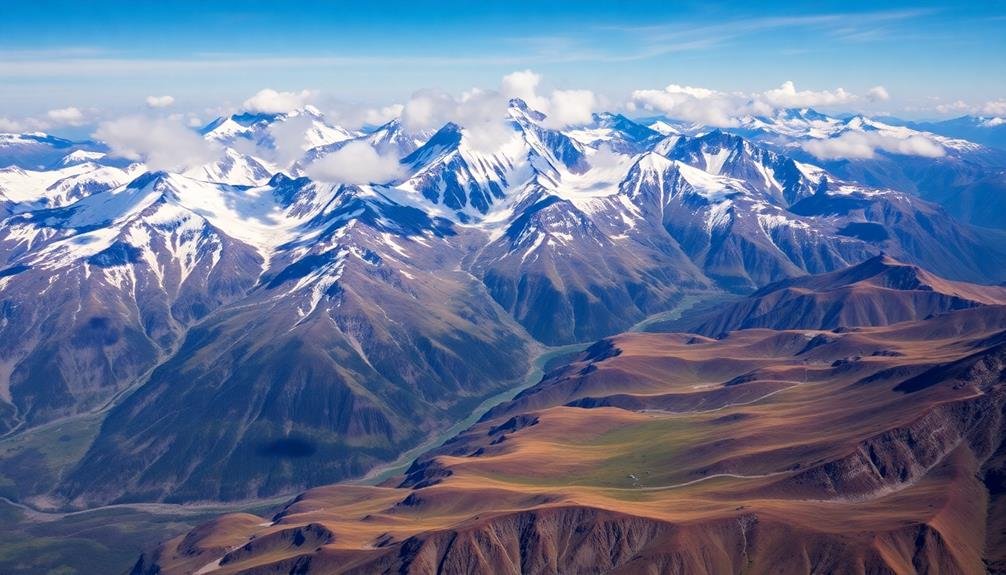
When viewed from above, landscapes reveal a tapestry of unique textures that aren't visible from the ground. From high altitudes, you'll notice patterns and formations that transform familiar terrain into abstract art. Rivers and streams become serpentine ribbons, while forests appear as intricate mosaics of varied greens and browns.
Farmlands create geometric patchworks, their neat rows and circles contrasting with the rugged textures of surrounding wilderness.
Desert landscapes offer particularly striking textures from above. You'll see rippling sand dunes, their ridges casting long shadows that accentuate their sculpted forms. Salt flats appear as cracked, otherworldly surfaces, while rocky outcrops create a sense of depth and dimensionality.
In mountainous regions, you'll capture the interplay of jagged peaks, smooth snowfields, and fractured glaciers. Coastal areas reveal the intricate patterns of tidal flats, coral reefs, and eroded cliffs.
Even urban landscapes take on a new character, with cityscapes resembling complex circuit boards.
To capture these unique textures effectively, you'll need to take into account your angle, lighting, and camera settings. Experiment with different altitudes and perspectives to highlight the most intriguing patterns and contrasts in the landscape below.
Revealing Hidden Landscape Patterns
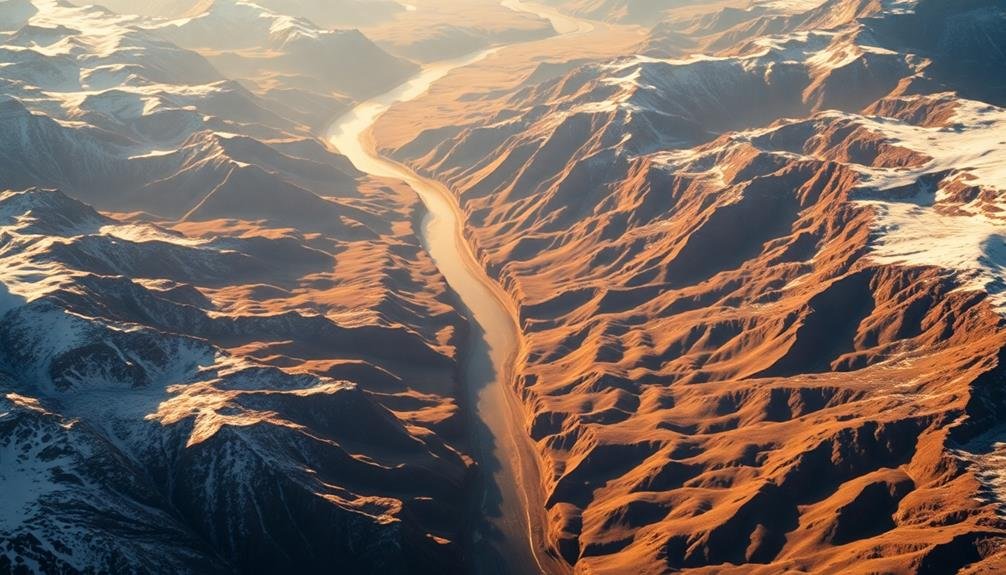
From high above, you'll discover landscape patterns that are invisible from the ground.
You can observe vast topographical features like mountain ranges, river systems, and geological formations in their entirety.
As you capture these aerial views, you'll notice natural color palettes emerging, showcasing the Earth's diverse hues and textures in ways that ground-level photography simply can't match.
Aerial Perspective Reveals Patterns
As you ascend to higher altitudes, a whole new world of landscape patterns emerges. From above, you'll notice intricate designs and structures that are impossible to perceive from the ground.
Aerial perspective reveals the true scale and interconnectedness of natural and human-made features, offering a unique visual feast for photographers and observers alike.
When you're capturing high-altitude landscape shots, you'll discover three main types of patterns:
- Natural formations: Rivers and their tributaries create dendritic patterns, while wind-sculpted sand dunes form mesmerizing ripples and waves.
- Agricultural layouts: Crop fields and irrigation systems produce geometric shapes and colorful patchworks that stretch across vast areas.
- Urban development: Cities and road networks form intricate grids, radial patterns, and organic growth structures that reflect human planning and expansion.
These patterns often tell stories about the land's geology, climate, and human influence.
You'll find that high-altitude photography allows you to capture these hidden narratives in a single frame, revealing the complex relationships between different landscape elements.
Topographical Features From Above
Countless topographical features become strikingly visible when viewed from above, revealing hidden landscape patterns that aren't apparent at ground level.
You'll notice how rivers snake through valleys, creating intricate dendritic patterns that resemble tree branches. Mountain ranges appear as ripples on the Earth's surface, their peaks and valleys forming a mesmerizing texture.
From high altitudes, you can spot geological formations like fault lines, volcanic calderas, and ancient impact craters that are often imperceptible on the ground.
Glacial landscapes reveal their true scale, with moraines, cirques, and U-shaped valleys showcasing the immense power of ice. Desert environments display vast networks of sand dunes, their rhythmic patterns stretching for miles.
You'll also observe how human activity has shaped the land. Agricultural fields create geometric patchworks of color, while urban areas form complex grids and radial patterns.
Roads and railways cut through the landscape, connecting distant points and highlighting the topography they traverse.
Natural Color Palettes Emerge
High-altitude landscape shots reveal a stunning array of natural color palettes that often go unnoticed from ground level. As you gaze down from above, you'll see Earth's hidden patterns emerge, creating a mesmerizing visual tapestry.
These colors aren't just beautiful; they're informative, telling stories about the landscape's geology, ecology, and human impact.
From this bird's-eye view, you'll notice:
- Subtle variations in vegetation hues, indicating different plant species or health conditions
- Geological formations exposed through layers of sediment and rock, each with its distinct shade
- Water bodies reflecting sky and surrounding landscapes, creating a dynamic interplay of colors
You'll find that seasons dramatically influence these palettes. Spring might bring vibrant greens and bursts of wildflower colors, while autumn paints the landscape in warm oranges and reds.
Even in seemingly monochromatic environments like deserts or snow-covered regions, you'll discover a surprising range of tones and textures.
High-altitude photography doesn't just capture colors; it reveals the intricate relationships between land, water, and life. It's a powerful tool for understanding our planet's complexity and beauty, offering insights that ground-level observations can't provide.
Weather's Impact on Scenery

At the mercy of Mother Nature, high-altitude landscapes transform dramatically with changing weather conditions. You'll witness how clouds, mist, and precipitation sculpt the scenery, creating ethereal atmospheres that can elevate your photographs.
Fog and low-lying clouds often blanket valleys, leaving mountaintops to pierce through like islands in a sea of white. This phenomenon, known as a temperature inversion, offers surreal compositions.
Storm clouds rolling in can cast dramatic shadows and create striking contrasts, while sunbeams breaking through gaps in the cloud cover spotlight specific areas of the landscape.
Snow and ice add a pristine white canvas to your frame, simplifying complex terrain and emphasizing the contours of the land. During the golden hours, these frozen surfaces reflect warm light, bathing the scene in a mesmerizing glow.
Rain can transform dry landscapes, bringing out vibrant colors and creating reflective surfaces. Rainbows often appear after showers, adding a magical element to your shots.
Atmospheric Effects at Altitude
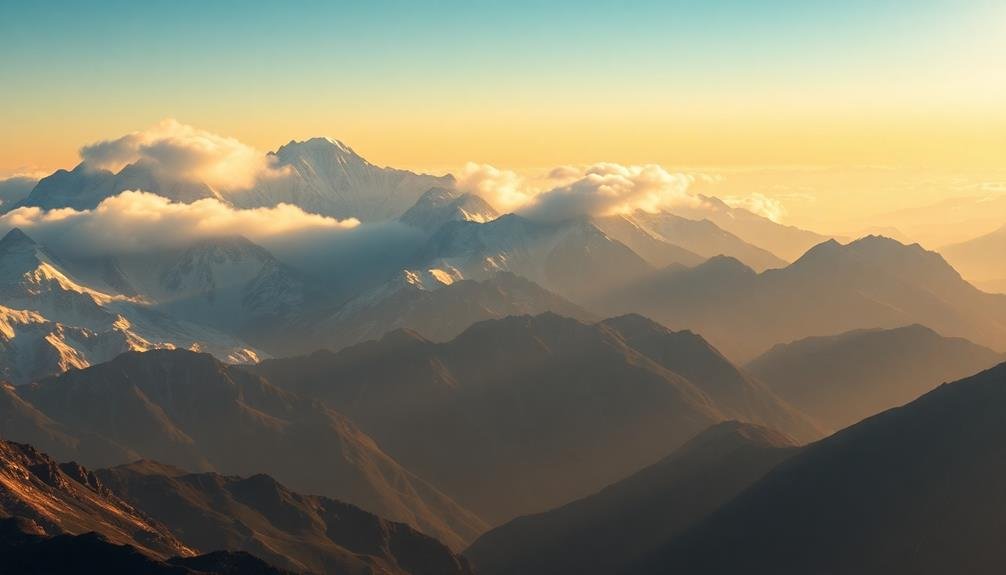
Grasping the unique atmospheric effects at high altitudes is essential for capturing stunning landscape shots. As you ascend, you'll notice the air becomes thinner, clearer, and often drier. This change in atmosphere creates visual phenomena that can elevate your photographs from ordinary to extraordinary.
At higher elevations, you'll encounter:
- Enhanced visibility: The clearer air allows you to see farther, capturing distant details that might be obscured at lower altitudes.
- Intensified colors: The thinner atmosphere filters less sunlight, resulting in more vibrant hues, especially during golden hour.
- Dramatic cloud formations: Unique weather patterns at altitude often produce spectacular cloud displays, adding depth and drama to your shots.
You'll also notice that shadows appear sharper and more defined due to the reduced atmospheric interference. This clarity can create striking contrasts in your images, particularly when photographing rugged terrain or architectural elements.
Additionally, the lower air pressure at high altitudes can lead to more unpredictable weather, offering opportunities for capturing dynamic scenes with rapidly changing light and atmospheric conditions.
Seasonal Changes From Above
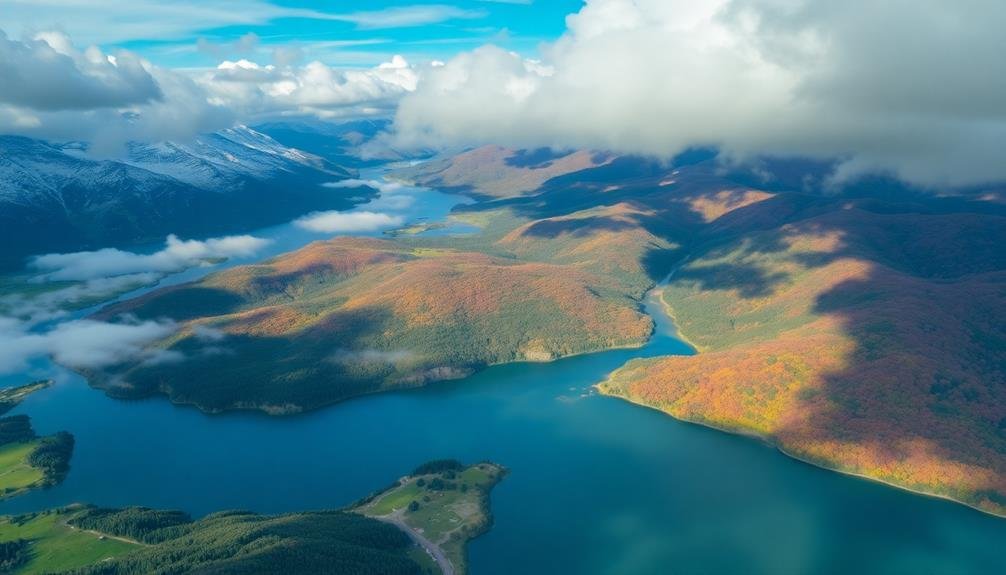
Capturing seasonal changes from a high vantage point offers a unique perspective on nature's grand alterations. From above, you'll witness vast landscapes shifting in color and texture as the seasons progress.
In spring, you'll see forests awakening with vibrant greens and meadows bursting with wildflowers. Summer brings lush, verdant canopies and golden fields of ripening crops.
As autumn arrives, you'll capture the breathtaking palette of reds, oranges, and yellows sweeping across deciduous forests. This aerial view allows you to document the gradual progression of fall colors as they spread across entire regions.
Winter transforms the landscape into a stark, monochromatic wonderland, with snow-capped mountains and frozen lakes creating striking geometric patterns.
From high altitudes, you'll also observe how seasonal changes affect human activities. You'll see agricultural patterns shift, recreational areas transform, and wildlife migration routes emerge.
These shots can reveal the intricate relationship between climate, geography, and ecosystems on a grand scale. By capturing these seasonal alterations from above, you'll create compelling visual narratives that showcase the dynamic nature of our planet and the cyclical rhythms that shape our environment.
Scale and Composition Challenges
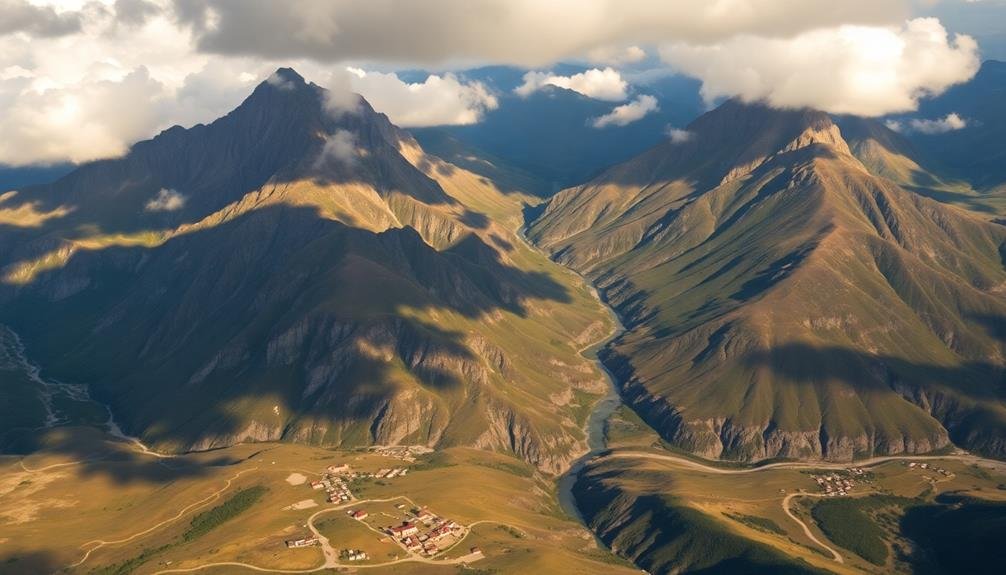
While seasonal changes offer stunning visual narratives, photographing landscapes from high altitudes presents unique challenges in scale and composition. You'll need to master new techniques to capture the grandeur of vast expanses below. From this vantage point, familiar elements like trees and buildings become minuscule, altering your usual sense of proportion.
To overcome these challenges:
- Use leading lines to guide the viewer's eye across the frame, emphasizing depth and scale. Rivers, roads, or mountain ridges can serve as natural pathways.
- Incorporate recognizable objects to provide a sense of scale. A lone house, vehicle, or boat can instantly convey the vastness of the surrounding landscape.
- Experiment with different focal lengths. Wide-angle lenses capture sweeping vistas, while telephoto lenses compress distant elements, creating unique perspectives.
You'll also need to take into account atmospheric conditions. Haze and cloud cover can obscure details, but they can also add depth and mood to your images.
Technical Considerations for Drones
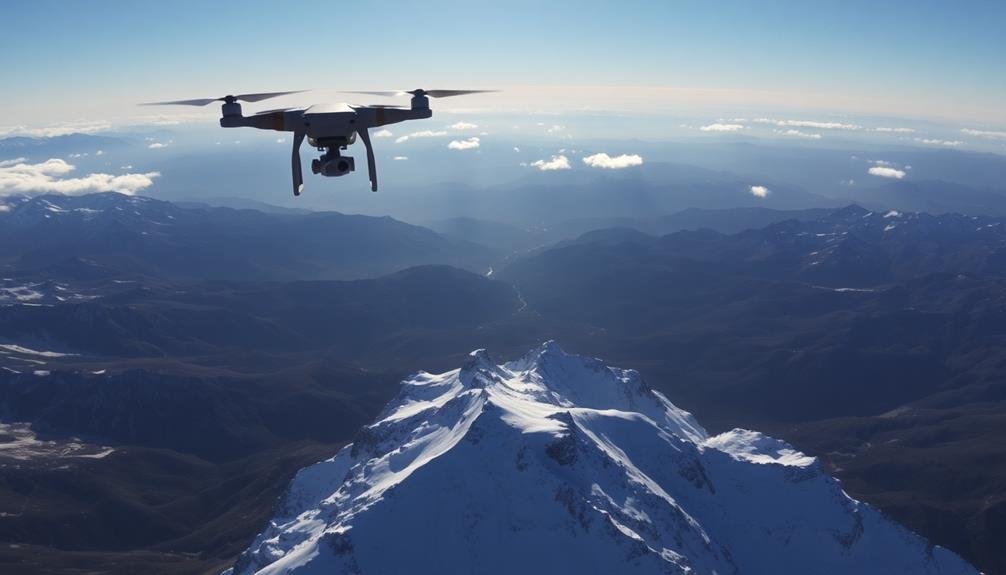
Numerous technical factors come into play when using drones for high-altitude landscape photography.
You'll need to be aware of your drone's flight time, as higher altitudes can drain batteries faster. It's vital to monitor your battery levels closely and plan your shots accordingly.
Wind speeds increase at higher altitudes, so you'll need to take into account your drone's stability and wind resistance.
Choose a drone with strong motors and advanced stabilization features to guarantee smooth footage and crisp images.
Temperature changes can affect your drone's performance, so be prepared for colder conditions at higher elevations.
Insulate your batteries and allow your drone to acclimate before takeoff.
You'll also need to take into account your camera settings.
Use a wider aperture to capture more light, and adjust your shutter speed to compensate for any movement.
RAW format is ideal for post-processing flexibility.
Frequently Asked Questions
What Safety Precautions Should Photographers Take When Shooting From High Altitudes?
When shooting from high altitudes, you should always prioritize safety. Secure your footing, use protective gear, stay hydrated, and be aware of altitude sickness. Don't take unnecessary risks for a shot; your well-being comes first.
How Do Different Camera Lenses Affect High-Altitude Landscape Photography?
When shooting high-altitude landscapes, you'll find wide-angle lenses capture sweeping vistas, while telephotos compress distant features. Zoom lenses offer versatility, but prime lenses often provide sharper images. Don't forget to take into account lens weight when hiking to locations.
Are There Legal Restrictions for Taking Aerial Photographs in Certain Areas?
Yes, there are legal restrictions for aerial photography in many areas. You'll need to check local laws, as some places prohibit drone use or require permits. Military zones, airports, and private property often have strict regulations.
How Can Photographers Minimize Motion Blur in High-Altitude Shots?
To minimize motion blur in high-altitude shots, you'll want to use a fast shutter speed, stabilize your camera with a tripod or gimbal, and enable image stabilization. Don't forget to shoot in burst mode for more options.
What Post-Processing Techniques Enhance High-Altitude Landscape Photographs?
You'll enhance high-altitude landscapes by adjusting contrast, boosting saturation, and sharpening details. Don't forget to balance highlights and shadows, apply graduated filters, and use HDR techniques to capture the full dynamic range of mountain scenes.
In Summary
You've seen how high-altitude landscape shots can transport you to another world. They reveal hidden patterns, textures, and perspectives you'd never experience from the ground. As you venture into aerial photography, remember to experiment with light, composition, and seasonal changes. Embrace the technical challenges and atmospheric effects unique to shooting from above. With practice, you'll capture breathtaking images that showcase Earth's beauty in ways that'll mesmerize viewers and yourself.

As educators and advocates for responsible drone use, we’re committed to sharing our knowledge and expertise with aspiring aerial photographers.




Leave a Reply